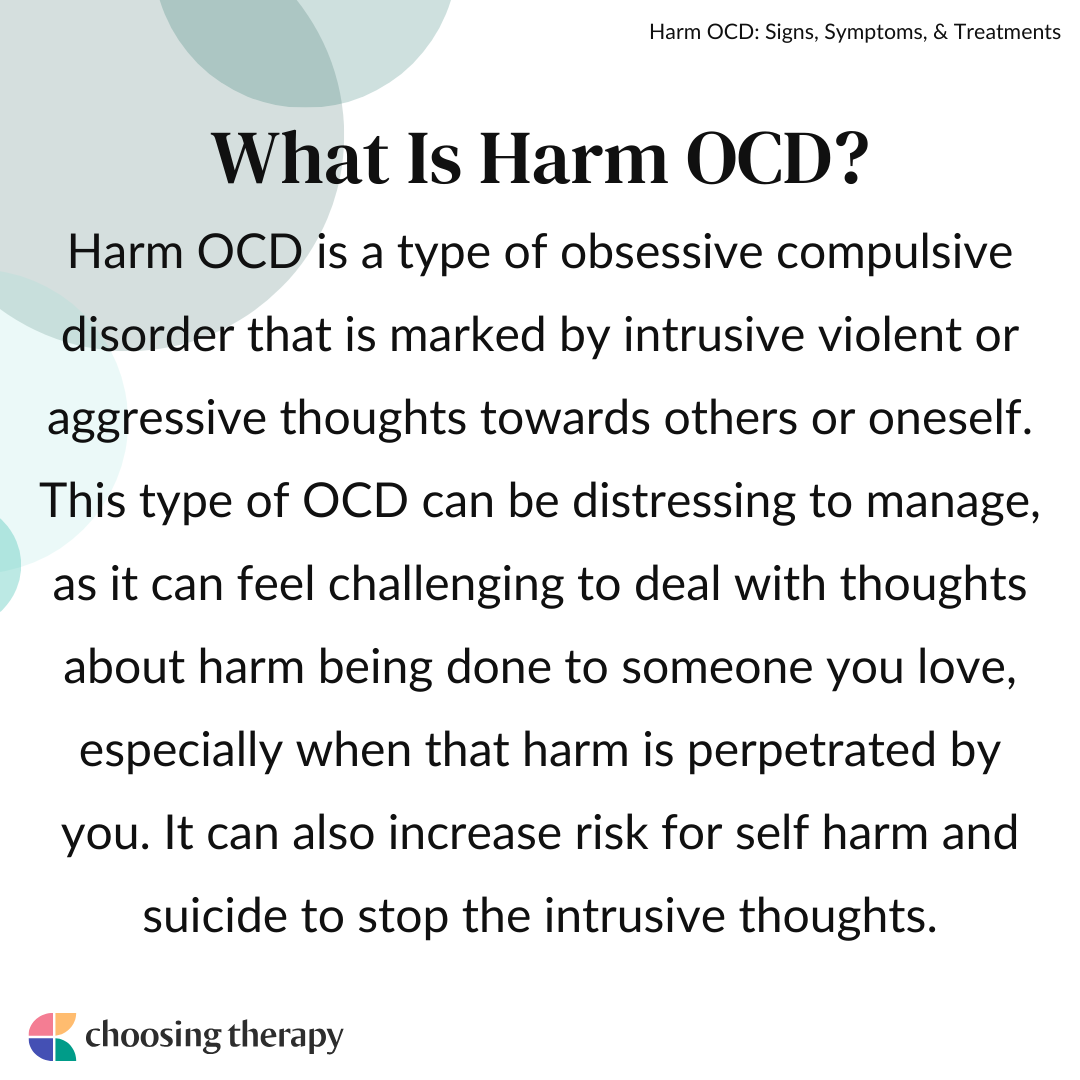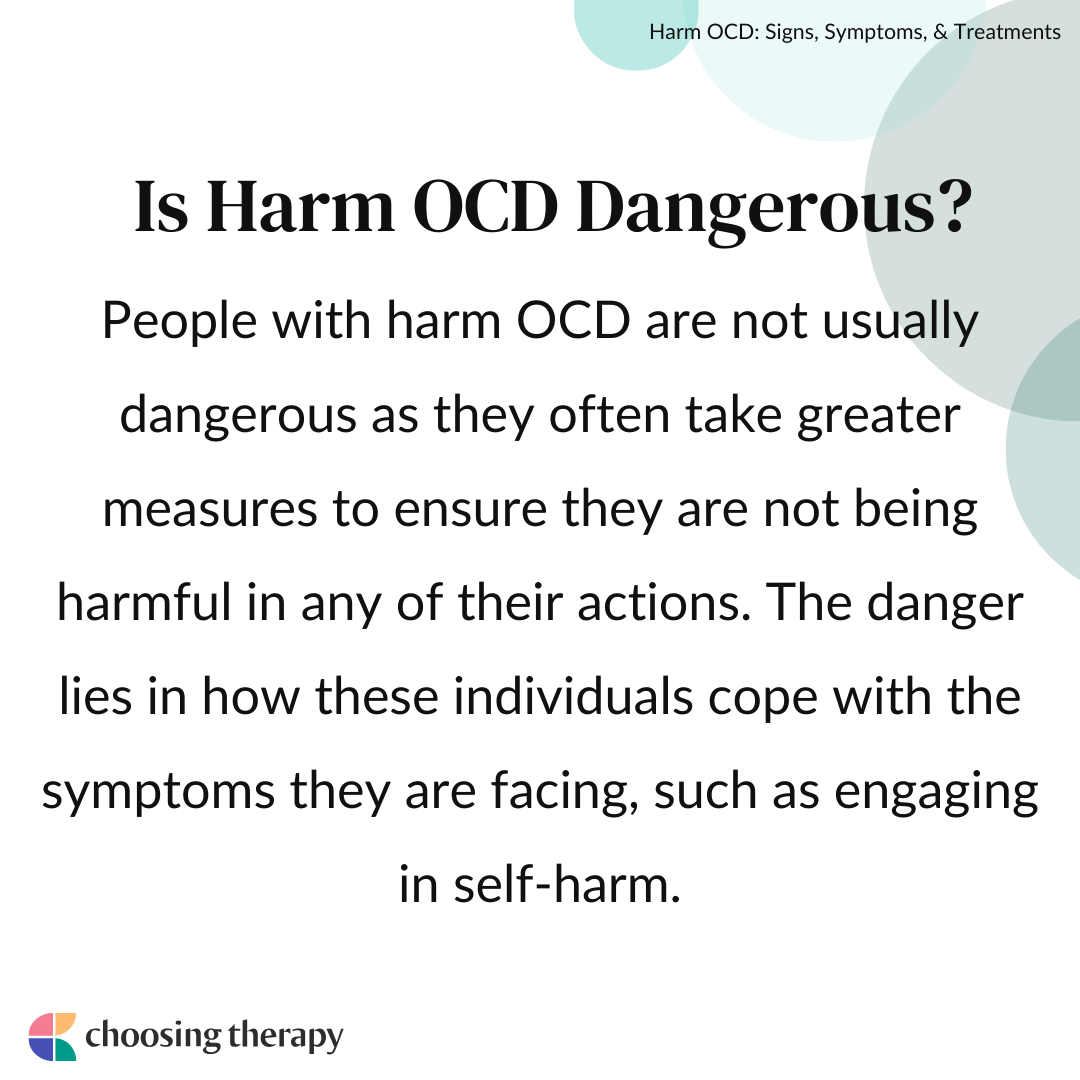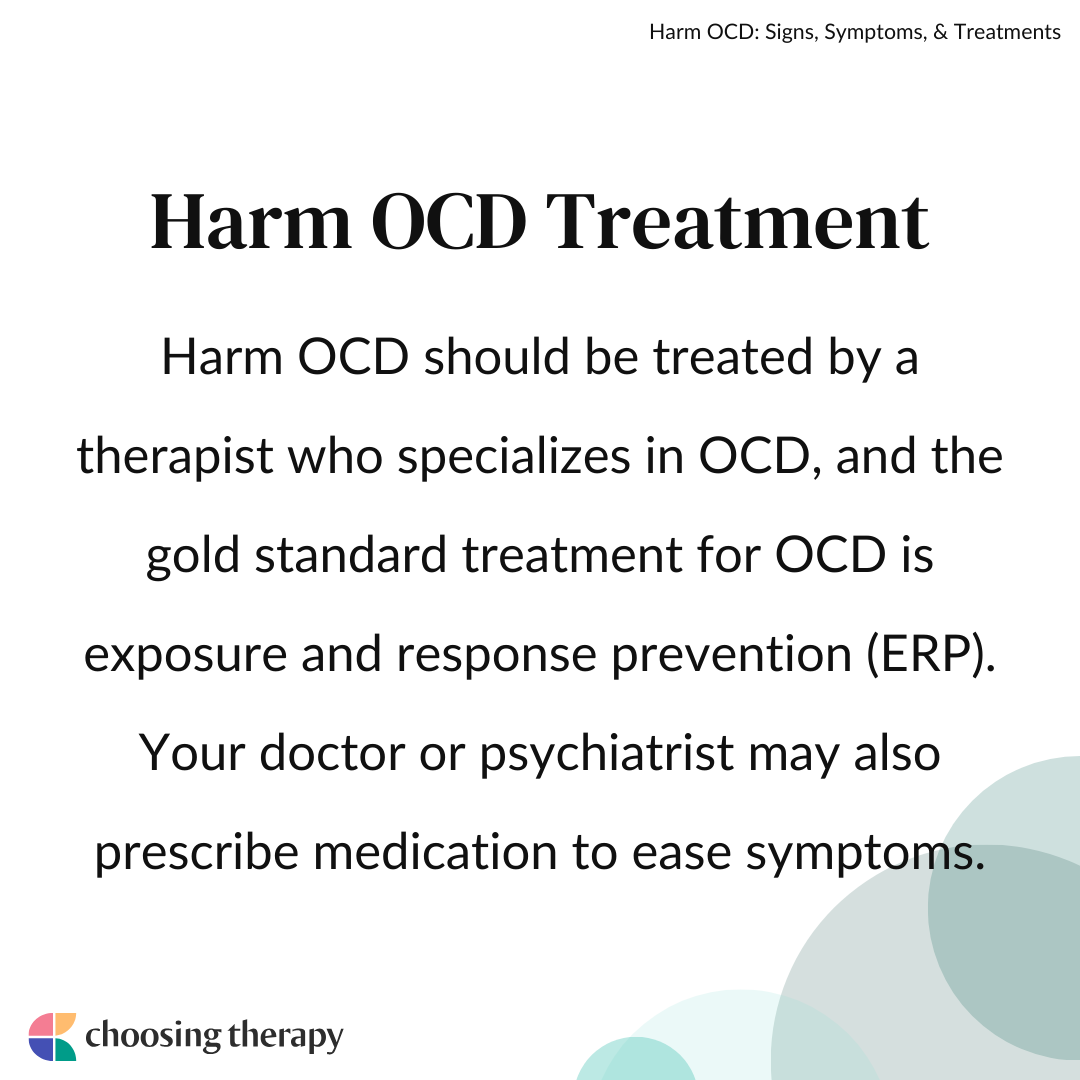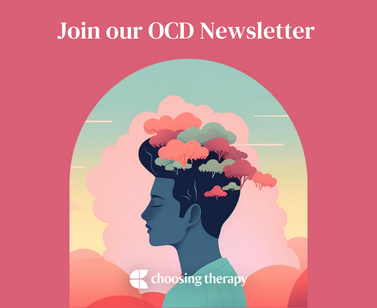Harm OCD involves intrusive thoughts of engaging in harmful behavior toward themselves or others. These thoughts are accompanied by compulsive behaviors designed to decrease the anxiety associated with those disturbing images. Without assistance from a trained mental health professional, symptoms of harm OCD can increase or worsen over time, but with appropriate treatment symptoms can be managed.
What is the best therapy for Harm OCD?
Exposure And Response Prevention Therapy (ERP) – Do live video sessions with a therapist specialized in ERP, the gold standard treatment for OCD. Treatment from NOCD is covered by many insurance plans. Start With A Free 15 Minute Call
What Is Harm OCD?
Harm OCD is a type of obsessive compulsive disorder that is marked by intrusive violent or aggressive thoughts towards others or oneself. This type of OCD can be distressing to manage, as it can feel challenging to deal with thoughts about harm being done to someone you love, especially when that harm is perpetrated by you. It can also increase risk for self harm and suicide to stop the intrusive thoughts.
What Is Self Harm OCD?
Self-harm OCD refers to recurrent, unwanted thoughts and fears about harming oneself. These thoughts might sound like, What if I actually do end my life? What if I really do swerve my car into this truck? What if I actually swallow all these pills? Does thinking about death mean I’m actually suicidal? These thoughts can also lead to fears around knives, sharp objects, and standing in high places.
How Common Is Harm OCD?
Exact statistics on harm OCD are unknown. However, it’s important to consider that intrusive thoughts about death and harm are extremely common, even in people who don’t have OCD. That said, harm OCD can be shameful and confusing to talk about, which means that people may be less likely to disclose it to their healthcare professionals.
Is Harm OCD Dangerous?
People with harm OCD are not usually dangerous as they often take greater measures to ensure they are not being harmful in any of their actions. The danger lies in how these individuals cope with the symptoms they are facing, such as engaging in self-harm.
Harm OCD Vs. Other OCD Subtypes
All types of OCD are characterized by obsessions and compulsions. Obsessions are recurrent, unwanted, and distressing thoughts, images, or impulses.1 Harm OCD involves a specific fear of harming oneself or others and subsequent checking compulsions. For example, harm OCD could manifest as a fear of running someone over with your vehicle, and the compulsion would be constant checking to make sure you haven’t.
People can typically discern fleeting thoughts from a desire to cause harm, but with harm OCD, you may interpret the thought to mean you will act on it. Or, you will need reassurance that you’re a good person, and then engage in compulsive behaviors to reduce anxiety and protect yourself against these feared behaviors.
Harm OCD Symptoms
Symptoms of harm OCD overlap with symptoms of traditional OCD, dealing with obsessive thinking and engaging in compulsive behavior to reduce the anxiety associated with these thoughts of harming someone or themselves.
Examples of Harm OCD Obsessions
Harm OCD obsessions can include intrusive thoughts like:
- Inflicting harm or pain on someone you love
- Having aggressive or violent images in their mind
- They are responsible for any pain that others may face
- Imposter syndrome
Examples of Harm OCD Compulsions
Harm OCD compulsions can include thoughts and behaviors like:
- Avoidance: People with harm OCD may avoid events or situations that they think could put them at risk of hurting themselves. For example, they might avoid using knives, driving on certain roads, or frequenting places where they experienced harm-based obsessions.
- Reassurance-seeking from others: People with harm OCD may seek reassurance from others to validate that they won’t actually hurt themselves. This can sound like, “Do you think I’d actually do that?” with the expectation that the other person will say no (which can temporarily soothe their anxiety).
- Mental review: Mental reviewing refers to considering past experiences as a way to provide self-reassurance. For example, someone with harm OCD might tell themselves, “I’ve never cut myself with this knife before, so I won’t do it now.”
- Mental rituals: Harm OCD can also coincide with mental rituals as a way to reassure someone they won’t hurt themselves. For example, they might try to consciously counteract a negative obsessive thought by reflecting on three things they feel positive about.
- Excessive research online: Some people with harm OCD will turn to online research to confirm that they are not like other people who commit violent crimes. This is also a form of seeking reassurance.
Treatment For OCD NOCD: Online OCD Treatment Covered By Insurance – Regain your life from OCD. Do live video sessions with a licensed therapist specialized in treating OCD. Treatment from NOCD is covered by most major insurance plans. Learn how you can use your insurance benefits. Visit NOCD Talkiatry: Is OCD Medication Right For You? Speak with A Doctor – Talkiatry can match you with a psychiatrist who takes your insurance and is accepting new patients. They’re in-network with major insurers and offer medication management with supportive therapy. Free Assessment
Signs of Harm OCD in Children
In children, harm OCD might present as intrusive what-if scenarios — “What if I accidentally cut myself with a knife?” or, “What if I kill my parents in their sleep?” The thoughts are upsetting because the child doesn’t want to engage in them.2 Also, while children generally seek out reassurance from their parents that they won’t engage in harmful behavior, adults tend to engage in compulsive reassurance or checking behaviors.
How to Know If You Have Harm OCD
It can be hard to know if you have harm OCD, or whether you’re experiencing another form of anxiety or negative thoughts related to another issue altogether.
Here are some questions you can ask yourself:
- Do I actually want to be violent?
- Am I an aggressive person?
- Why do I want to harm this person?
- How do I feel about this person?
- Do I constantly check to make sure I haven’t caused harm?
- Are these thoughts taking up a lot of my time?
What Causes Harm OCD?
Researchers and mental health professionals don’t know a lot about what causes or triggers the symptoms of traditional and harm OCD, but there are theories based on observable and recorded common factors.3
Common factors that may lead to, trigger, or be associated with harm OCD include:4
- Family history of OCD
- Stressful or traumatic life events
- Co-occurring mental health disorders
- Learned behaviors
- Brain chemistry
Getting a Harm OCD Diagnosis
Harm OCD will likely be diagnosed by a psychiatrist. A therapist and psychiatrist will work together to come up with a diagnosis and treatment approach after reviewing therapy notes and having sessions together to assess symptoms.
How much do you know about OCD? Take This 11-Question OCD Quiz From NOCD. If you or a loved one are struggling with OCD, NOCD provides convenient, affordable, and effective OCD treatment covered by most major insurance plans.
Harm OCD Treatment
Harm OCD should be treated by a therapist who specializes in OCD, and the gold standard treatment for OCD is exposure and response prevention. Your doctor or psychiatrist may also prescribe medication to ease symptoms.
There are three specific therapy techniques commonly used to manage harm OCD and traditional OCD:5
Exposure and Response Prevention (ERP)
In ERP therapy for OCD, you’re exposed over time to desensitize you to anxiety-provoking stimuli. You and your therapist will formulate a list of feared items (called a hierarchy of fears). Gradually, you will be exposed to those items with the therapist’s guidance to avoid the usual compulsive responses.5
Exposure can be imaginal (imagining the feared situation) or in vivo (directly encountering the feared situation). For example, if you have a fear around knives, your therapist might use in vivo exposure to gently introduce you to being around knives without engaging in your usual compulsive responses (reassurance-seeking, mental rituals, etc.) Although you will likely feel anxious at first, the repeated exposure can create a desensitized effect.
Interoceptive exposure refers to deliberately identifying the physical reactions experienced when an obsessive thought arises. For example, it’s common for people to have a faster heart rate when they feel overwhelmed. Your therapist might encourage you to do some push-ups (which will also induce a faster heart rate) as a way of habituating you to this somatic response.
Mindfulness-Based CBT
Mindfulness-based CBT is designed to teach an observational vs. judgmental stance regarding thoughts, feelings, urges, and physical sensations. Those with harm OCD learn that the mere existence of a disturbing thought is not indicative of their character and doesn’t point to an intent to cause harm to self or others.
Cognitive Restructuring
People with harm OCD may struggle with cognitive distortions, including all-or-nothing thinking, catastrophizing, and perfectionism. Cognitive restructuring helps you to identify and challenge those thoughts with more rational, objective, evidence-based thinking. The goal is for automatic thoughts to become rational and less distorted.
Medication for Harm OCD
In some cases, OCD medication may be recommended in addition to therapy. The therapist will likely refer you to a psychiatrist or psychiatric nurse practitioner who can prescribe the appropriate type and dose. Clomipramine (Anafranil), fluoxetine (Prozac), fluvoxamine (Luvox), and sertraline (Zoloft) are all approved by the U.S. Food and Drug Administration (FDA) for treatment of OCD.
Lifestyle Changes to Help With Harm OCD Symptoms
In addition to therapy and medication management, you can make lifestyle changes to better manage harm OCD and its symptoms.
- Stress management: OCD symptoms are exacerbated by heightened stress and anxiety, so anything you can do to reduce stress helps.
- Mindfulness: Mindfulness will help you manage your obsessional thinking. As it becomes more natural, the automatic thoughts you react to as a part of your OCD will be easier to manage.
- Support system: Joining a support group or increasing your circle of trusted friends can help with feelings of loneliness, judgment, or isolation. There are several online OCD resources for people looking for extra support.
- Healthy habits: Engaging in self-care is crucial for anyone dealing with a mental health condition. Well-balanced meals, regular movement, and adequate sleep are all necessary to manage stress, mood, and anxiety.
How to Get Help for Harm OCD
To receive help for harm OCD, locate a trained mental health professional who specializes in OCD. Your primary care physician (PCP) may have a list of therapists and psychiatrists in your area. You could also use an online therapist directory that makes it easy to look up specific criteria for a therapist, including insurance coverage, populations treated, and types of treatment offered. Consult your insurance carrier by calling the customer service number on your card or looking on the online portal. You could also use an online OCD treatment provider like NOCD.
How to Get Help for a Loved One
If you have a loved one with harm OCD and they give you permission, you can assist them by calling providers and insurance companies. It may also be helpful for you to attend certain appointments or provide transportation. Additionally, reassure them that you support them without judgment.
How to Get Help For a Child
Ask your child’s pediatrician for a list of therapists and psychiatrists who not only specialize in OCD but also treat children. A family therapist is also helpful to assist families dealing with mental health issues such as OCD. These conditions impact the entire family, and a family therapist can help you manage.
Online provider directories and insurance portals can help you locate a family therapist in your area. Search provider websites to see what types of services they offer, what insurance they accept, and what types of patient populations they treat. Many therapists offer telehealth services, making treatment even more accessible.
6 Ways to Cope With Harm OCD
In addition to therapy, prescribed medication like SSRIs, and lifestyle changes, there are several other ways to cope with harm OCD. These OCD coping skills may lessen the negative impact of symptoms.
Here are six ways to cope with harm OCD:
- Develop flexible routines: Learning to be less rigid about daily routines can help improve relationships and encourage a willingness to try new things.
- Resist avoidance: Avoidance may sometimes seem logical, but it perpetuates the OCD cycle by intensifying the desire to avoid.
- Set realistic expectations: One way to manage self-doubt and frustration is by being realistic about goals and expectations. You and your team can discuss what treatment will achieve and how long that may take to accomplish. For many cases, the goal is a reduction in symptoms and not the total elimination of them.
- Manage stress: Stress has the potential to worsen symptoms, so learning new ways to reduce it is important.
- Increase social interaction: Social interactions can have a positive impact on our physical and mental health. They reduce stress and increase an overall sense of well-being.
- Practice mindfulness & meditation: Practicing mindfulness and meditation for OCD can assist those with harm OCD to shift focus from over-thinking to a less judgmental stance.
Harm OCD Statistics
Here are several relevant statistics according to available data regarding OCD and the subset of harm OCD:
- 85% of the population report graphic or violent thoughts from time to time6
- 25% of those with OCD have a family member with OCD6
- 30% of the population are perfectionist, but only 2.5% have OCD6
- OCD is over twice as common in adults than in children6
- 1.2% of adults in the US were affected by OCD last year7
- 1 in 100 adults (2-3 million) and 1 in 200 children (500,00) are affected by OCD in the US8
- Rates of OCD are higher in females (1.8%) than in males (.5%)9
To help our readers take the next step in their mental health journey, Choosing Therapy has partnered with leaders in mental health and wellness. Choosing Therapy is compensated for marketing by the companies included below. OCD Therapy NOCD: Effective, Affordable, & Convenient OCD Therapy Do live, face-to-face video sessions with a therapist who specializes in treating OCD and get 24/7 support between sessions. NOCD is covered by many insurance plans and is available nationwide. Visit NOCD Treatment From An Online Psychiatrist Talkiatry OCD is treatable. Talkiatry specializes in OCD and provides personalized care with medication and additional support. Get started with a short assessment. OCD Newsletter A free newsletter from Choosing Therapy for those impacted by OCD. Get helpful tips and the latest information. Sign-UpAdditional Resources
What to know when finding a therapist for OCD With so much information out there regarding providers and treatment options for obsessive compulsive disorder, it can be hard to know exactly where to start—especially when you have to consider everything from the type of provider to the different treatment methods, as well as how you’ll fit it into your busy schedule. Can OCD make it hard to make decisions? From choosing what to wear in the morning to picking what to eat for dinner, decision-making is a part of everyone’s daily routine. But for millions of people with Obsessive-Compulsive Disorder (OCD), making any choice can feel like a daunting, sometimes impossible task.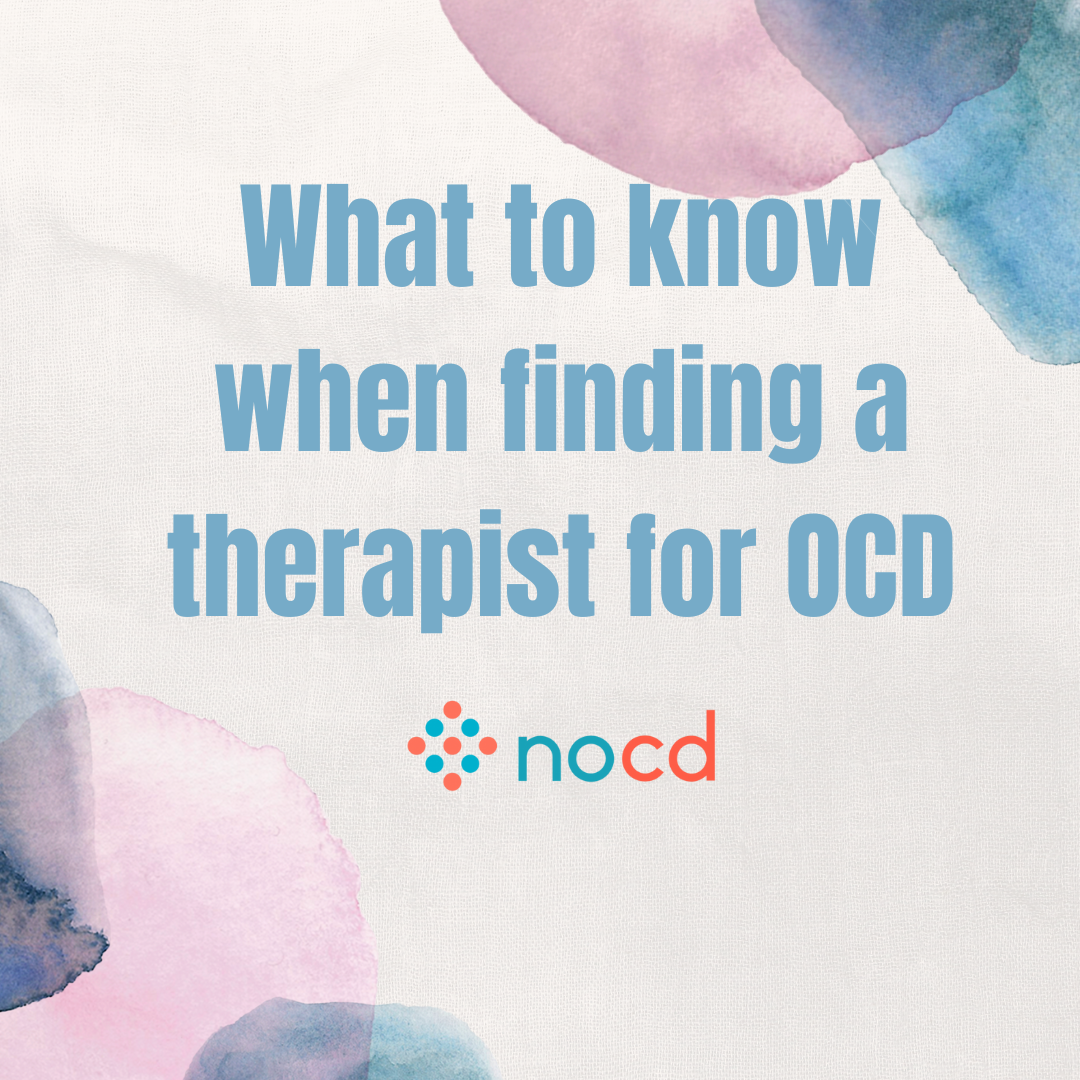
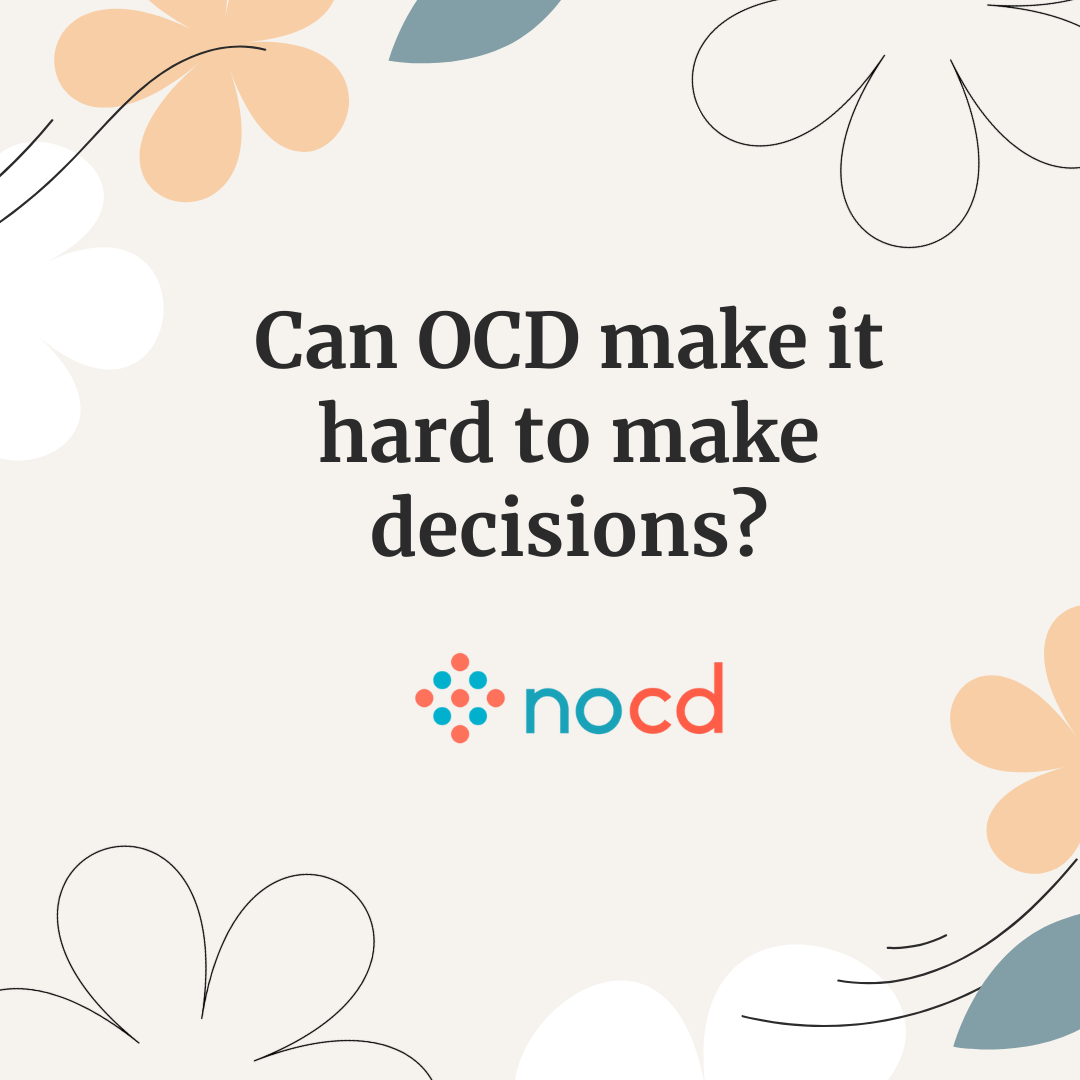
Harm OCD Infographics
